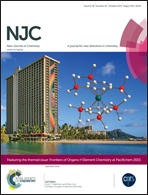A DFT and QTAIM study of the novel d-block metal complexes with tetraoxa[8]circulene-based ligands†
Abstract
A series of transition metal (d-block metals) ion complexes with the tetraoxa[8]circulene-based ligand having one- and two-decker (sandwich-type) structures has been designed and studied in the framework of the DFT approach. The quantum theory of atoms in molecules (QTAIM) was additionally applied for the studied complexes with the aim of evaluating their peculiar electronic features. The obtained results indicate that the complexation process depends on matching of the transition metal cation size to the size of the tetraoxa[8]circulene-formed cavity similar to the formation of the crown ether complexes. Coordination bonds of the d-block metal ions with the neighbouring oxygen atoms in the studied complexes can be interpreted as an intermediate type of interaction. The binding energy of the coordinative M–O bonds has been calculated both by the Espinosa equation and the DFT additive scheme in order to confirm the high stability of the studied systems. If the size of metal cations is larger than the corresponding crown cavity the formation of two-decker complexes with the two tetraoxa[8]circulene-based ligands is possible. Such sandwich-type complexes possess the unusual cubic coordination polyhedron of the central metal ion bound to eight oxygen atoms. Moreover, these complexes are additionally stabilized due to the presence of π-stacking interactions between the two opposite tetraoxa[8]circulene parallel sheets. The synthesis of the proposed π-extended tetraoxa[8]circulene sheets and their metal-complexation ability attract special attention because of their promising application as potential biomimetic-type nanopores.
![Graphical abstract: A DFT and QTAIM study of the novel d-block metal complexes with tetraoxa[8]circulene-based ligands](/en/Image/Get?imageInfo.ImageType=GA&imageInfo.ImageIdentifier.ManuscriptID=C5NJ01255D&imageInfo.ImageIdentifier.Year=2015)

 Please wait while we load your content...
Please wait while we load your content...